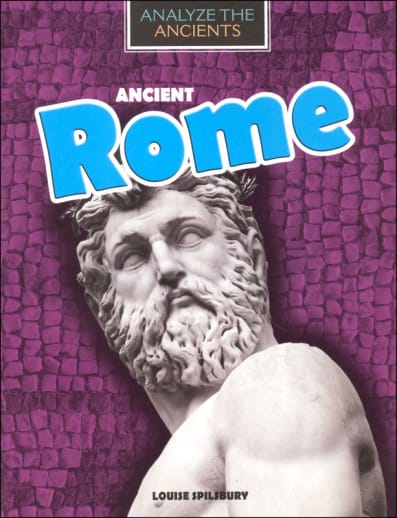How does an ancient wolf statue symbolize Rome? What Roman city was completely buried in ash in 79 AD? Step back in time, learning these amazing stories and more with stunning, full-color photographs! See amazing archaeological finds such as the intact stone roads, beautiful mosaics, and important temples used for worship, revealing how every level of society functioned. Test your knowledge with fun questions throughout the book, then check your answers in the back to see if you were right. This nonfiction book is a wonderful, rich way to learn history. Includes suggested resources and websites for further information. 48 pgs, paperback.
Analyze the Ancients: Ancient Rome
SKU
000976
ISBN
9781538225592
Grade 4-6
These icons are designed to help you quickly understand and learn important information about our products.
Teaching Method
Traditional
Teacher-centered curriculum commonly used in classrooms that may include a text, teacher manual, tests, etc.
Charlotte Mason
A methodology based on the work of a 19th century educator who maintained that children learn best from literature (Living Books), not textbooks.
Classical
A methodology based on the Latin Trivium (three stages of learning), including the grammar stage (memorization and facts), logic stage (critical thinking), and rhetoric stage (developing/defending ideas).
Unit Study
A thematic or topical approach centered around one topic that integrates multiple subject areas.
Montessori (Discovery)
A methodology based on the work of a 20th century educator that emphasizes student and sensory-driven discovery learning and real-life applications.
Other
Other methodologies
Religious Content
Secular
Contains content contrary to common Christian beliefs (i.e. evolution).
Neutral
Avoids religious or theoretical topics or presents multiple viewpoints without preference.
Christian/Religious
Faith-based or including instructional religious content.
Learning Modality
Auditory
Learns through listening, talking out loud or reading out loud.
Visual
Learns through seeing, prefers written instructions and visual materials.
Kinesthetic/Tactile (Hands-On)
Learns through moving, doing and touching.
Multi-Sensory
Curriculum that employ a variety of activities/components.
Presentation
Sequential
Curriculum progresses through well-defined learning objectives. Emphasizes mastery before moving to the next topic.
Spiral
Topics and concepts are repeated from level to level, adding more depth at each pass and connecting with review.
Conceptual/Topical
Focus is on the “why,” often with a unifying concept as well as specific skills; coverage may be broader.
Teacher Involvement
Low Teacher Involvement
Student-led materials; parent acts as a facilitator.
Medium Teacher Involvement
A mix of teacher-led time and independent student work.
High Teacher Involvement
Teacher-led lessons; may utilize discussions, hands-on activities and working together.
Additional Materials Required
No other materials needed
Everything you need is included.
Other Materials Required
There are additional required resources that are a separate purchase.
Other Materials Optional
There are additional resources mentioned or recommended but are not absolutely necessary.
Consumable
Consumable
Designed to be written in; not reusable.
Non-Consumable
Not designed to be written in; reusable.
Our Price
$15.05 $15.05 $10.50
Rainbow Savings: $4.55
Description
Publisher's Description of Analyze the Ancients: Ancient Rome
The amazing accomplishments of Ancient Rome can still feel like a mystery to many. From the modern day calendar to the earliest incarnation of the book, it is stunning to learn how many innovations came from this advanced civilization. Along with learning about the culture, readers get the chance to study amazing Roman artifacts. They're asked to put their thinking caps on, and using questions and prompts, draw their own conclusions about Ancient Rome. This book is sure to wow readers with Rome's impressive civilization and excite them enough to discover some facts on their own.
Category Description for Analyze the Ancients
Give your student the opportunity to examine and draw conclusions from information people have learned from artifacts from the past to learn how ancient people groups lived. They will learn about topics such as leadership styles, religions, food sources, beliefs, and celebrations. The substance in this series of informational history books was constructed using social studies curricula from around the United States. These books would be great book report resources or supplements to a world history curriculum. ~Judy
Details
| Product Format: | Paperback |
|---|---|
| Grades: | 4-6 |
| Brand: | Rosen Classroom |
| ISBN: | 9781538225592 |
| Length in Inches: | 9.25 |
| Width in Inches: | 7.125 |
| Height in Inches: | 0.125 |
| Weight in Pounds: | 0.3 |
Videos
Reviews

